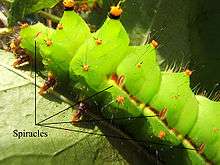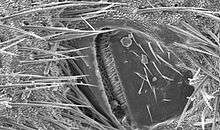Spiracle (arthropods)
A spiracle or stigma is the opening in the exoskeletons of insects and some more derived spiders to allow air to enter the trachea.[1] In the respiratory system of insects, the tracheal tubes primarily deliver oxygen directly into the animals' tissues. The spiracles can be opened and closed in an efficient manner to reduce water loss. This is done by contracting closer muscles surrounding the spiracle. In order to open, the muscle relaxes. The closer muscle is controlled by the central nervous system, but can also react to localized chemical stimuli. Several aquatic insects have similar or alternative closing methods to prevent water from entering the trachea. The timing and duration of spiracle closures can affect the respiratory rates of the organism.[2] Spiracles may also be surrounded by hairs to minimize bulk air movement around the opening, and thus minimize water loss.


Literature
- Chapman, R.F. (1998): The Insects, Cambridge University Press
References
- Solomon, Eldra, Linda Berg, Diana Martin (2002): Biology. Brooks/Cole
- Wilmer, Pat, Graham Stone, and Ian Johnston (2005). Environmental Physiology of Animals. United Kingdom: Blackwell Publishing. pp. 171–172.CS1 maint: multiple names: authors list (link)